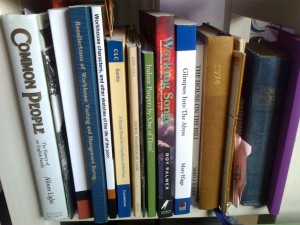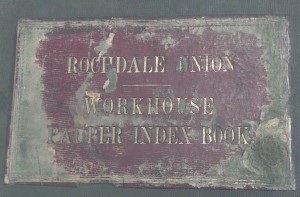Carran’s Diary 26: Writing on the Wall 3: SkEtching a book
On Breaking the Rule Book:
“The thing is, not everyone does it by the book. In the south, they do it by the book, but in the north they don’t do anything by the book. They don’t believe in the book. In Rochdale, they’ve thrown the book out. They don’t believe in the new ways.” (Matron)
The Book came about through reading…not rocket science. The reading was a very important part of the housework of course and that sounds silly now to say but I took that literally and played at “reading the research” in making and playing the work. This turned into the sections where Matron reads from the big book; the pauper reads from the bible; the archivist/pauper/I read(s) from the boxes of archive materials and I read from the lecture notes. A visitor advised me to make a big book instead of reading from a small book. This made me think about scale more than I had done up to that point when she visited in April 2015. This was a key comment.
Books: the gospel and the bible and the rule book, rules for workhouses, notices and labels and museum exhibits, the history, herstory, ….accounts, columns, ins and outs, archives boxes of books, pamphlets and papers, documentation, the forms we fill in, payments for making the family book which used to be the big family bible where births were recorded, accessing death and birth certificates, private papers, swearing on the book, signing to say you won’t copy etc etc etc. learning Latin.
I think my research in archives so far has cost approximately …..much more than…..:
£10 photographing
£90 search fees
£30 copying
£8 digital copying
£60 birth and death certificates
£400 research trip to Suffolk (four days)
and I could spend so much more. It’s big business family history research. The market may be retired people; those with supposed disposable incomes but it is quite a lot of money to shell out and the shelling always reveals the next layer of research and the necessity to re-search: it’s an aspect of archive fever and it feeds itself through the system that is current in terms of public access and data protection. How else can depleted resources of local government, once free services, keep going? Photocopying has always been very expensive with a mark up to compete with a high street shop.
You may know this already but rather than pay the monthly fees to the genealogy sites you can get a look inside the big books for free down the library and email the info back to yourself to ponder over at home but if you want more hidden stuff….you have to pay and what you pay helps to pay all the book and box keepers who walk up and down corridors of shelving and climb up and down steps and go in and out of doors locked with keys to rooms kept at certain temperatures if the treasure is very special.
That aside, the book is also the one we use in theatre making: the document of the production: doing it by the book….the script…. Keeping the book….the technician’s manual. Not everyone does it by the book….sometimes you go off the book and find something new, especially when the work is still in a process. If it’s “make it up as you go along” maybe you throw the book out, but:
“I don’t do that…I play it by the book up and down the country, I do….but not for long, they’re going to start using the book to check now. I don’t want to be checked up on, I want to do the checking…”
said Matron or what she might have said or some of what she did say – well not exactly – going “off the book” so to speak.
Here is an example of going off the book:
I once saw the “book” used in the RSC Judi Dench, Ian Mckellen, Trevor Nunn, version of the play whose name they never speak (behind the scenes so to speak) because it’s a bad omen if you utter the word…so I will help reinforce that mythical status here. It was a ledger from the 1970s and it mentioned things like “Today Judi went to the dentist..the show ran over” It kind of added to my experience of that version of the play which I saw a long time before all this House thing happened. I read that ledger in 2010, about thirty or so years after Judi went to the dentist. Needless to say we don’t know the name of the person’s handwriting in that particular ledger – she (the deputy ? stage manager) belongs to the army of invisibles who serve the names of people with lights around them whose names are written down for everyone to see because that’s what we like to do – drop names of big people: it makes us feel like we know them, especially if they go to the dentist, just like us. Judi is a few months younger than my mum and my aunt is 101. I see my mum whenever I can. I have seen my 101 year old aunt about three times in my life and will see her a fourth time next year hopefully, she lives in Canada. I have seen Judi many times on the big platform, through the big looking glass end on window and the little corner placed window and the window you put on your lap which I used today to knit this thing about books mixing metaphors because when I come back to the working house I just spend my time making it up as I go along – like life.
And they’ll go on and on and on and on…in a kind of stream of conscious “trying to prove they’ve done so much” way when they come up to you with their CVs (Job Adviser/morphed Matron in The House) – not exactly as it in in the book/script.
Book is also table: book on back, burden of book. Book is therefore step manual, letter from job centre, platform, stage, – the open book, the calling to account, standing on the open page, body is open page, blank page, no words, speechless just about breathing because there’s so much to say and so little time in the interview to say it …. shrink wrapping around the book, suffocation of packaging, pack the book in a bag. Alice, didn’t read the book properly/correctly….Sanctioned! Stamp Rubber! Stamp….Next!
“Books” that come to me through the little window on my lap and take Alice’s reading of “In the circumstances in which you find yourself where you are unfit….you are unfit for..It’s not that I’m unfit….” to another level.
and
Advice from another visitor: What might happen if you mix up all the cards (life books/characters in the performance) and did them in a different order. How would that book read? Play for me is a body book, because I write it on my feet, so to speak.
My Booklist:
Book List: The House
- Bartley George C.T. A Handy Book for Guardians of the Poor. Cambridge University Press (1876 and 2011)
- Cole, John Down Poorhouse Lane: The Diary of a Rochdale Wokhouse. George Kelsall Publishing (1994)
- Digby, Anne. British Welfare Policy: Workhouse to Workfare Faber and Faber (1989)
- Edwards, Christine. Lexden and Winstree Union Workhouse (St Albright’s Hospital London Road, Stanway. Belhus Books (2009)
- Goss, John ed. Daily Express Community Song Book. Daily Express (1927)
- Gough, Anthony W. A Short History of The Parish Church of St Mary the Virgin, Peldon. Peldon Parochial Church Council (1997)
- Hardy, Sheila. The House on The Hill: The Samford House of Industry 1764-1930 The Gipping Press Ltd. (2001)
- Higginbotham, Peter. Indoor Paupers by ‘One of Them’ Workhouse Press (2013)
- Higgs, Mary. Glimpses Into The AbyssS. King and Son (1906)
- Light, Alison. Common People – The History of an English Family. Fig Tree (2014
- Nevinson, Margaret Wynne. Workhouse Characters and Other Sketches of the Life of the Poor George Allen and Unwin Ltd. (1918)
- Palmer, Roy ed. Poverty Knock: a picture of industrial life in the nineteenth-century through songs, ballads and contemporary accounts. Cambridge University Press (1974)
- Palmer, Roy. Working Songs: Industrial ballads and poems from Britain and Ireland 1780s-1980s Herron Publishing (2010)
- Robert, Ronald. Pea Soup On Friday: Some Personal Notes on the History of Birch Hill Hospital. Rochdale Area Health Authority (1982)
- Smith, Edward. A Guide to the Construction and Management of Workhouses: Together With The Consolidated Order…of the Poor Law Board. Knight and Co. (1870)
- Smith, Susannah. The Workhouse Southwell. National Trust (2002)
- Twining, Louisa. Recollections of Workhouse Visiting and Management During Twenty-five Years – Primary Source Edition. Kegan Paul and Co. (1880)
- Waterfield, Mary A Suffolk Punch – out of the darkness. Mary Wade (2004)




Comments are closed
Sorry, but you cannot leave a comment for this post.